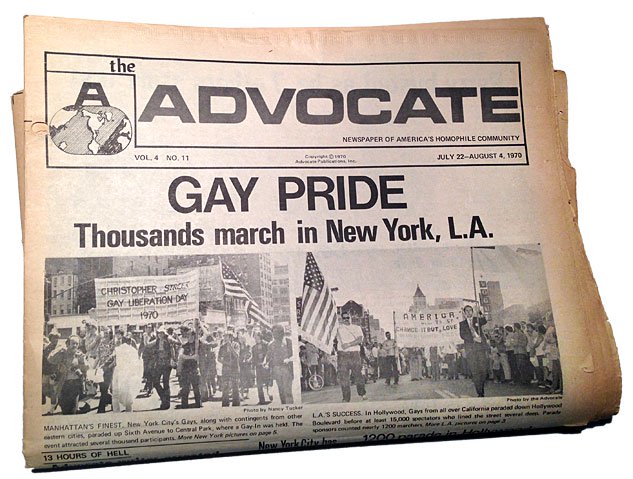Pride Parades: Past, Present and Future
Written by Jasica Gill
Illustration by Natalie Cassidy
Every year June rolls around and we get bombarded with rainbows and “love wins” t-shirts, stickers, and everything in between. There’s nothing wrong with rainbows, or the aforementioned sentiment; however when these symbols are used by large brands to commodify the LGBTQI community it becomes more than a little troublesome. These same brands generally ignore the LGBTQI community the rest of the 11 months of the year and rarely, if ever, donate to organizations dedicated to supporting LGBTQI people. Of course seeing representations of LGBTQI folks in mainstream media is important and should continue to happen, but it shouldn’t be the only effort--it should be followed by investing money and resources into the LGBTQI community year round. As of late, too much attention has been placed on stores and apps adding rainbows to their logos during the month of Pride, instead of remembering the bold resistance of butch lesbians and Black and Brown trans women -- the true pioneers of Pride month.
Patrons outside the Stonewall Inn, 1969. Library of Congress.
The LGBTQI community had been fighting for its right to be treated with the same respect and to be given the equal opportunities well before 1969; however, this would become the year that these issues would come to the forefront. The riots that took place at the Stonewall Inn in Manhattan, NY, began not long after midnight on June 28th when police decided to raid the popularly known gay bar under the guise of enforcing liquor licensing laws. The patrons of the bar, who were used to this routine excuse, knew this was less about liquor laws and more about policing LGBTQI folks, especially those who were dressed in what was considered unacceptable for their assigned gender at birth. Although raids like these were not unusual for the time, the events that followed sparked the birth of Pride parades nationwide, and eventually throughout the world. Since this was no isolated incident, the victims of this raid and even onlookers finally decided it was time to act up and fight back. As LGBTQI patrons of the bar were being arrested and hauled out of the Stonewall Inn, a cop clubbed Stormé DeLaverie, a Black, butch lesbian, who retaliated by punching the cop right back. Many records cite her yelling at onlookers, “why don’t you guys do something!”, which then brought on crowds of people throwing whatever they could get their hands on at the police, and erupting into a violent resistance.
Stonewall Inn, 1969 by Diana Davies
The riots lasted several days. Many records show that two iconic activists, Marsha P. Johnson and Sylvia Rivera, stood at the forefront of the Stonewall riot. Johnson confirmed that she went to the Stonewall Inn the night of the riot to give her full support. In June 2001, at an event hosted by the Latino Gay Men of New York (LGMNY), Rivera gave a speech about her experience at the Stonewall Inn riots. In the speech, she said that while she did not incite the riots, she was there in solidarity.
Both Johnson and Rivera were frontliners of the gay rights movement and played a vital role in ensuring a better quality life for all LGBTQI folks decades after the 1969 riots.The two focused on the most vulnerable part of their community and provided whatever they could with what little they had. They even opened what would become the first shelter for homeless LGBTQI youth.
Sylvia Rivera, left, and Marsha P. Johnson protest at a rally for gay rights in New York in 1973. (Diana Davies/Manuscripts and Archives Division, The New York Public Library)
As LGBTQI issues unfolded in the mainstream media, the narrative shifted toward highlighting white members within the community and minimized the impact of the original activists like Johnson and Rivera. Nonetheless, Johnson continued to organize and devote much of her life to the gay rights movement and AIDS epidemic. She spent her time fundraising, looking after friends on their death beds, and marching alongside the activist group ACT UP.
Marsha P. Johnson (left) and Sylvia Rivera (right), co-founders of the Street Transvestite Action Revolutionaries (STAR) at the Christopher Street Liberation Day Gay Pride Parade, New York City, June 24, 1973. Credit: Leonard Fink, courtesy LGBT Community Center National History Archive.
That night of June 1969 sparked a change in tactic from within the LGBTQI community to ensure more visibility and to demand space for its people. As a result, Pride parades were created to honor the brave patrons of the Stonewall Inn who fought fearlessly that night in June. A year after Stonewall, cities such as Chicago, NYC, LA and San Francisco all held marches to commemorate the riots. From its inception, the march called for no dress code or age regulations. This opened the event up to anyone who wanted to join and encouraged a freedom of expression, which was something the LGBTQI community was often denied.
Randy Burns, co-founder of Gay American Indians, walks during the Pride parade in San Francisco, Sunday, June 25, 2017 By Chiu
Today, we have Pride parades in cities all over the US and world. They serve as a way for the community to come together and celebrate itself, loved ones, and remember the efforts of those who put in the work to get us to this current moment of visibility and power.
It is no secret that there is still a massive amount of work that needs to be done within the LGBTQI community, specifically regarding Black and Brown trans women and their safety. The number of Black and Brown trans women who are violently murdered continues to grow, while little to no media coverage exists for this frightening and unjust reality. Instead, the focus is on brands and their opportunist campaigns trying to capitalize off the LGBTQI community without doing any real work for us. The current administration openly discriminates against trans women and has set into motion multiple policies that create obstacle after obstacle for Black and Brown trans women. One of these policies include using someone’s assigned gender at birth to determine which facility they are housed in while in prison, instead of taking into account the gender identity they identify with. Another policy seeks to strengthen laws that allow healthcare professionals to deny service to anyone who is deemed unworthy based on their own faith and “conscience.” It is exactly what it sounds like: legal discrimination.
Front page of The Advocate covering Pride Marches, July 22, 1970
Pride month and the parades held during it should be a celebration, but too often they are overshadowed by aesthetics. There are more than enough rainbows, but not nearly as much information being circulated about the history at Stonewall Inn or how to help the most vulnerable parts of the community: Black and Brown trans women.
To commemorate Pride, we spoke to a number of Black and Brown LGBTQI folks this month about “what Pride means” to them. An overwhelming amount of people pointed to their intimate relationship with this month. Many of them detailed how it is a month where they check in with themselves, celebrate themselves, and remember to honor all the activists and every day LGBTQI people that came before them to fight for a life free of discrimination and unjust hardships. Most of the people I spoke to did not declare their excitement for the parades themselves, and instead spoke about the presence of police at these events and how it deters them from attending. In an ideal world, Pride parades would be free of large corporations and brands trying to make money off a community they could care less about. Pride parades should feel like a complete safe haven, instead of a raging party where the essence of community is lost amongst a crowd made up of empty slogans, police, and quite frankly far too many straight people getting drunk under the guise of being an “ally.”







